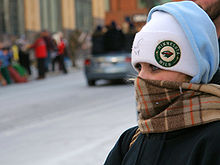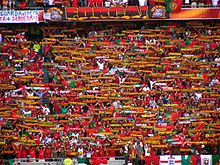Scarf

A scarf is a piece of fabric worn around the neck, or near the head or around the waist for warmth, cleanliness, fashion or for religious reasons. They can come in a variety of different colours.
History
Ancient Rome is one of the first origins of the scarf, where it was not used to keep warm, but to keep clean. It was called the sudarium, which translates from Latin to English as "sweat cloth", and was used to wipe the sweat from the neck and face in hot weather. They were originally worn by men around their neck or tied to their belt. Soon women started using the scarves, which were made of cloth and not made of wool, pashmina, or silk, and ever since the scarf has been fashionable among women.[1]
Historians believe that during the reign of the Chinese Emperor Cheng, scarves made of cloth were used to identify officers or the rank of Chinese warriors.[1]
In later times scarves were also worn by soldiers of all ranks in Croatia around the 17th century. The only difference in the soldiers' scarves that designated a difference in rank was that the officers had silk scarves whilst the other ranks were issued with cotton scarves. The men's scarves were sometimes referred to as "cravats" (from the French cravate, meaning "Croat"), and were the precursor of the necktie[citation needed].
The scarf became a real fashion accessory by the early 19th century for both men and women. By the middle of the 20th century scarves became one of the most essential[citation needed] and versatile clothing accessories for both men and women.
In recent years, scarves have experienced a revival.[2]
Uses and types
In cold climates, a thick knitted scarf, often of wool, is tied around the neck to keep warm. This is usually accompanied by a warm hat and heavy coat.
In drier, dustier warm climates, or in environments where there are many airborne contaminants, a thin headscarf, kerchief, or bandanna is often worn over the head to keep the hair clean. Over time, this custom has evolved into a fashionable item in many cultures, particularly among women. The cravat, an ancestor of the necktie and bow tie, evolved from scarves of this sort in Croatia[citation needed].
Religions such as Judaism under Halakhah (Jewish Law) promotes modest dress code among women. Married Jewish women wear a tichel to cover their hair. The Tallit is commonly worn by Jewish men especially for prayers which they wrap around their head to recite the blessing of the Tallit.
Young Sikh boys, and sometimes girls often wear a bandanna to cover their hair, before moving onto the turban. Older Sikhs may wear them as an under-turban.
Islam promotes modest dress among men and women; many Muslim women wear a headscarf often known as a hijab, and in Quranic Arabic as the khimar. The Keffiyeh is commonly used by Muslim men.
Several Christian denominations include a scarf known as a Stole as part of their liturgical vestments.
Silk scarfs were used by pilots of early aircraft in order to keep oily smoke from the exhaust out of their mouths while flying. Silk Scarfs were worn by pilots of closed cockpit aircraft to prevent neck chafing, especially fighter pilots, who were constantly turning their heads from side to side watching for enemy aircraft.
Wollen scarfs with Bandhani work are becoming very popular. Bandhani or Bandhej is the name of the tie and dye technique used commonly in Bhuj and Mandvi of Kutch District of Gujarat State in India.
Scarfs can be tied in many ways including the pussy-cat bow, the square knot, the cowboy bib, the ascot knot, the loop, the necktie, and the gypsy kerchief.[3]
Uniforms
Students in the United Kingdom traditionally wear academic scarves with distinctive combinations of striped colours identifying their individual university or college.

Members of the Scouting Movement wear scarfs as part of their uniform, with different colours and logos to represent their scout group. They are also used at camps to represent units, subcamps or the camp as a whole. Fun scarves are also used as memorabilia at Scout events and country scarves are often traded at international gatherings.
Bib scarf
The US Army and other American military units often wore branch of service colour or camouflage bib scarves with various uniforms.
Scarf Masks
Scarf Masks are scarves with an insertable mask that can help prevent against airborne illness, pollution, and pollen. G'ru is the only company that produces scarf masks[4].
Sport

Since at least the early 1900s, when the phenomenon began in Britain, coloured scarves have been traditional supporter wear for fans of association football teams across the world, even those in warmer climates. These scarves come in a wide variety of sizes and are made in a club's particular colours and may contain the club crest, pictures of renowned players, and various slogans relating to the history of the club and its rivalry with others. At some clubs supporters will sometimes perform a 'scarf wall' in which all supporters in a section of the stadium will stretch out their scarves above their heads with both hands, creating an impressive 'wall' of colour. This is usually accompanied by the singing of a club anthem such as "You'll Never Walk Alone" at Liverpool F.C.[5] or "Grazie Roma" at A.S. Roma. This was initially solely a British phenomenon, but has since spread to the rest of Europe, North and South America.
Scarf wearing is also a noted feature of support for Australian rules football clubs in the Australian Football League. The scarves are in the form of alternating bars of colour, usually with the team name or mascot written on each second bar.
Manufacturing of scarfs
The craft of knitting garments such as scarves is an important trade in some countries. Hand-knitted scarves are still common as gifts as well.
Printed scarves are additionally offered internationally through high fashion design houses such as Burberry, Missoni, Alexander McQueen, Cole Haan, Chanel, Etro, Lanvin, Hermès, Nicole Miller, Ferragamo, Emilio Pucci, Dior, Fendi, Louis Vuitton and Prada, for example.
There are three basic scarf shapes: square, triangular and rectangular.[6]
The leading manufacturer of fashion scarves used today is China with India, Hong Kong and Indonesia close behind. The most common materials used to make fashion scarves are silk, fleece, pashmina and cashmere.[7]
See also
References
- ^ a b Smith, Patrick. "History of the scarf". Retrieved April 19, 2011.
- ^ "Scarves History". Silk Scarves India.
- ^ Perry, Patricia, (1971). "Everything About Sewing Ponchos Capes Scarves & Stoles", New York: Butterick Fashion Marketing Company. 70-169062
- ^ www.breathegru.com
- ^ You'll Never Walk Alone, Liverpool Football Club, 2005
- ^ Perry, Patricia, (1971). "Everything About Sewing Ponchos Capes Scarves & Stoles", New York: Butterick Fashion Marketing Company. 70-169062
- ^ "Ties that Bind - History of Fashion Scarves". ScarfAid. Retrieved April 19, 2011.
